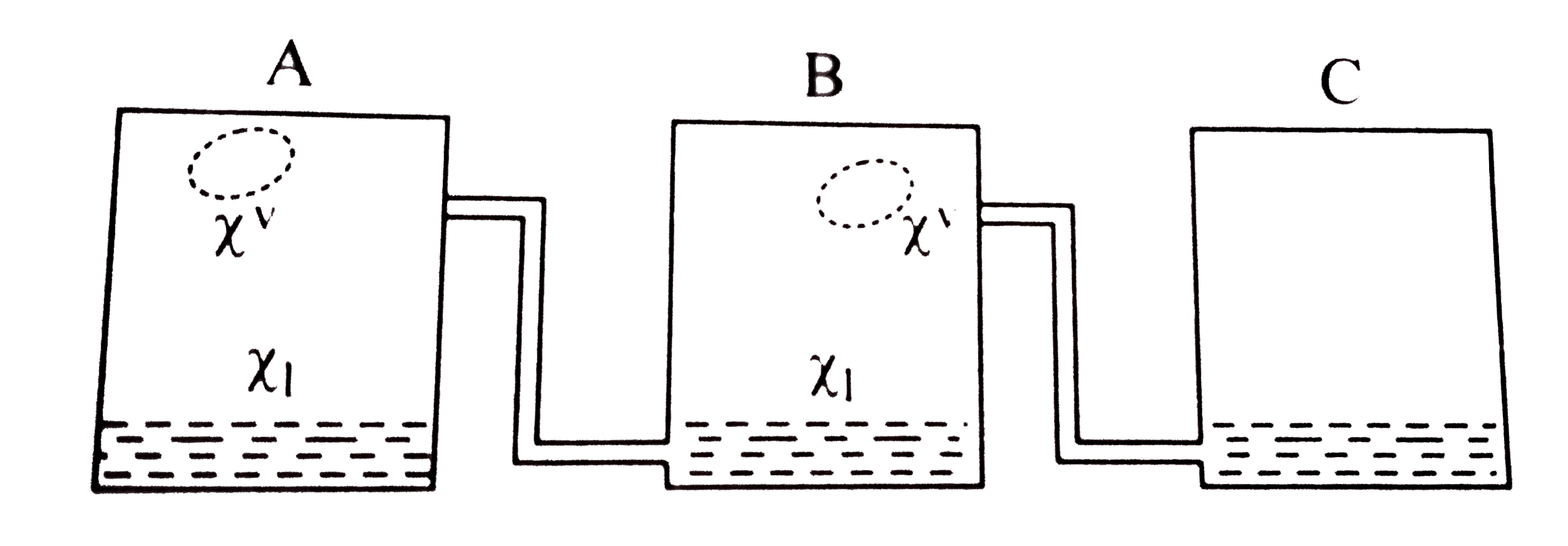Liquids A and B form an ideal mixture, in which the mole fraction of A is 0.25. At temperature T, a small quantity of the vapour in equilibrium with the liquid is collected and condensed. This process is repeated for a second time with first condensate. The second condensate now contains 0.645 mole fraction of A. Calculate the ratio (P∘A/P∘B). What will be the mole fraction of B in the third condensate?
Mole fraction of A(χA)=0.25
Mole fraction of B(χB)=0.75
After first condensation
Partial presssure of A(pA)=P∘AχA=P∘A×0.25
Partial presssure of B(pB)=P∘B×0.75
∴pApB=P∘AP∘B×0.250.75
After second condensation
Mole fraction of A(χA)=0.645
Mole fraction of B(χB)=1−0.645=0.355
Ratio of partial pressures
p/p_(A)^A=(p∘Ap∘B)2×0.250.75=0.6450.345
∴(p∘Ap∘B)2=0.6450.345×0.750.25
∴P∘AP∘B=2.33
After third condensation
p'/p_(A)^A'=(p∘Ap∘B)3×0.250.75=(2.33)3×0.250.75=4.242
∴Mole fraction of B
p'/p_(B)^B'+pB'=15.42=0.191=Mole fraction of B
Topper's Solved these Questions
- SOLUTIONSBOOK - CENGAGE CHEMISTRYCHAPTER - SOLUTIONSEXERCISE - Exercises (Linked Comprehension)
58 Videos
- SOLUTIONSBOOK - CENGAGE CHEMISTRYCHAPTER - SOLUTIONSEXERCISE - Exercises (Multiple Correct)
25 Videos
- SOLUTIONSBOOK - CENGAGE CHEMISTRYCHAPTER - SOLUTIONSEXERCISE - Ex 2.3 (Objective)
9 Videos
- SOLID STATEBOOK - CENGAGE CHEMISTRYCHAPTER - SOLID STATEEXERCISE - Ex 1.2 (Objective)
9 Videos
- SURFACE CHEMISTRYBOOK - CENGAGE CHEMISTRYCHAPTER - SURFACE CHEMISTRYEXERCISE - Archives Subjective
2 Videos
Similar Questions
Liquids 'A' and 'B' form an ideal solution. If the mole- fraction of 'A' in liquid and vapour forms at equilibrium is 0.4 and 0.6, respectively, the value of P0AP0B is.
View SolutionLiquids X and Y form an ideal solution. The vapour pressure of X and Y at 100∘C are 300 and 100mm of Hg, respectively. Suppose that a solution composed of 1mol of X and 1mol of Y at 100∘C is collected and condensed. This condensate is then heated at 100∘C and vapour is again condensed to form a liquid A. What is the mole fraction of X in A ?

View Solution
Knowledge Check
Two liquids A and B have P∘A and P∘B in the ratio of 1:3 and the ratio of number of moles of A and B in liquid phase are 1:3 then mole fraction of A in vapour phase in equilibrium with the solution is equal to :
A0.1B0.2C0.5D1.0Two liquids A and B have P0A:P0B=1:3 at a certain temperature. If the mole fraction ratio of xA:xB=1:3, the mole fraction of A in vapour in equilibrium with the solution at a given temperature is :
A0.1B0.2C0.5D1.0Two liquids A and B have P∘A and P∘B in the ratio of 1:3 and the ratio of number of moles of A and B in liquid phase are 1:3 then mole fraction of A in vapour phase in equilibrium with the solution is equal to :
A0.1B0.2C0.5D1.0
The vapour pressure of two pure liquids, A and B that form an ideal solution are 300 and 800 torr respectively, at temperature T. A mixture of the vapour of A and B for which the mole fraction of A is 0.25 is slowly compressed at temperature T, Calculate
(a) the composition of the first drop of the condesate,
(b) the total pressure when this drop is formed,
(c) the composition of the solution whose normal boiling point is T,
(d) the pressure when only the last bubble of vapour remains, and
(e) the composition of the last bubble.
View SolutionTwo liquids A and B have P∘AandP∘B in the ratio of 1 : 3 and the ratio of number of moles of A and B in liquid phese are 1 : 3 then mole fraction of 'A' in vapour phase in equilibrium with the solution is equal to :
View SolutionTwo liquids A and B have vapour pressure in the ratio P∘A:P∘B=1:3 at a certain temperature. Assume A and B form an ideal solution and the ratio of mole fractions of A to B in the vapour phase is 4:3. Then the mole fraction of B in the solution at the same temperature is :-
View SolutionTwo liquid A and B have vapour pressure in the ratio P∘A:P∘B=1.3 at a certain temperature.Assume A and B from an ideal solution and the ratio of mole fractions of A to B in the vapour phase is 4 : 3, then the mole fraction of B in the solution at the same tempreature is :
View SolutionTwo liquids A and B have P∘AandP∘B in the ratio of 1 : 3 and the ratio of number of moles of A and B in liquid phese are 1 : 3 then mole fraction of 'A' in vapour phase in equilibrium with the solution is equal to :
View Solution
